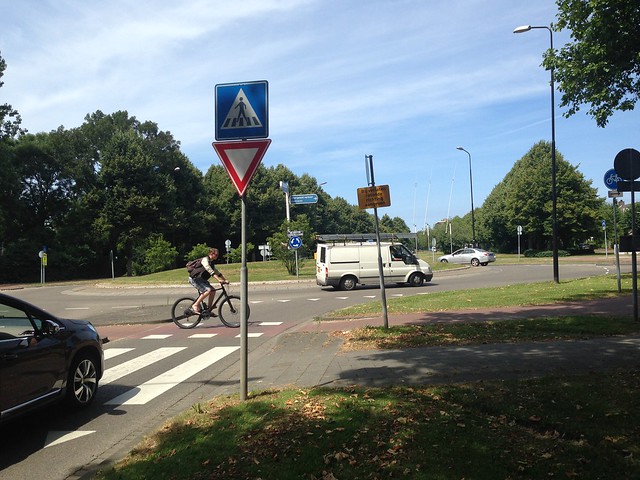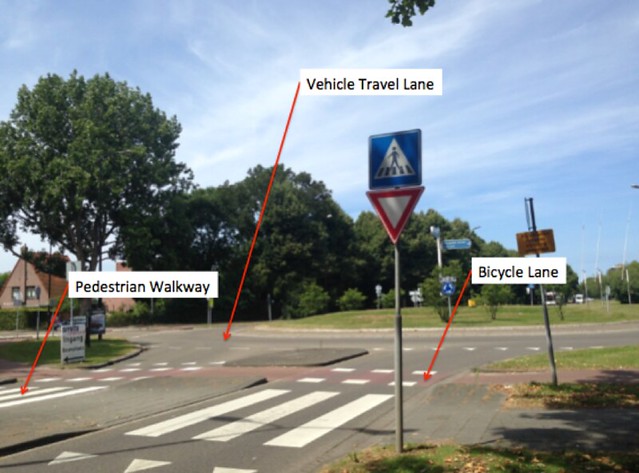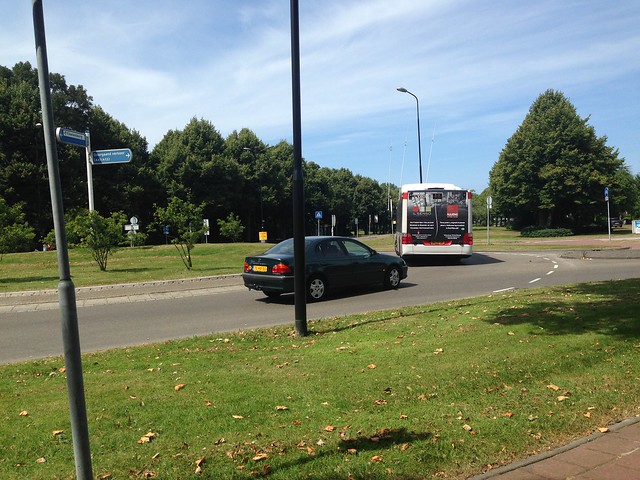Lynda Nitka and Jorden van Emmerik
ROUNDABOUTS
Intersection of Winston Churchilllaan and Schaapweg
Write up:
Location of Roundabout (See Figure 1 Below)
Figure 1: Location of Roundabout at Intersection of Sir Winston Churchillaan and Schaapweg
Sustainable Safety Aspects
1) Functionality of roads
The roundabout at Sir Winston Churchillaan and Schaapweg functions as a distributor road, since it is distributing access to motor vehicles, buses, bicycles, and pedestrians to get from one street to another.
2) Homogeneity and/or speed and direction
The roundabout separates speed, direction, and mass because of the fact that motor vehiclists, cyclists, and pedestrians all have their own paths to travel on (See Figure 2 below). That way, the heavier and faster motor vehicles are not risking the lives of the lighter and slower pedestrians and bicyclists.
Figure 2: Different spaces for walking, biking, and cars
3) Predictability of road course and road user behavior by a recognizable road design
The roundabout’s design provides predictability for its users because of the fact that the pedestrian walkway, bicycle lane, and vehicle travel lane all have their own type of pavement. Specifically, the pedestrian walkway has a tiled stone material for its path, the bicycle lane has a painted red asphalt material, and the vehicle travel lane has a black asphalt material. Additionally, the pavement markings and signage for the roundabout provide predictability for its users. Precisely, the motor vehicles have the shark’s teeth so that motor vehicles know to yield to both pedestrians and cyclists, and pedestrians and cyclists know that they have the priority. In addition, the pedestrian walkway has the crosswalk so that pedestrians know which lane is theirs. Furthermore, cyclists also have the elephant feet pavement markings so that they know which lane is theirs and that they have priority. Also, the sign in the middle of the roundabout with the circulating arrows informs in which direction all travellers are to travel the roundabout. This provides predictability for the travellers to abide by the rules of the roundabout design.
4) Forgivingness of the environment and of road users
One of the main ways that the roundabout design provides forgivingness is by having the mountable apron in its center. Especially because of the fact that this roundabout serves two different bus stations, this is important because the radius of the roundabout is too small for most buses and trucks to travel only in the vehicle travel lane (about 37 meters or 121 feet) (See Figure 3 below).
Figure 3: Bus using the mountable apron to make the turn around the roundabout
Therefore, by providing the mountable apron, trucks and buses are able to use the extra space while turning in the roundabout. Additionally, the roundabout limits the amount of injury that would occur at an intersection because of the fact that vehicles, bicycles, and pedestrians are all separated and enter the roundabout at approximate 90 degree angles, which forces the modes of transportation to travel slowly.
5) State awareness by the road user
The roundabout’s design takes into account knowing the capability of the travellers because of the fact, again, that the roundabout provides homogeneity and slow speeds. This makes sure that the road users are forced to be aware of their surroundings. If a road user is travelling at slow speeds in a travel lane that only contains their own mode of transportation, he or she should be capable of using the roundabout safely.
Roundabout Design Questions
Main objective
To completely separate heavy and light traffic at a major roundabout, through the tactic of providing separate facilities for pedestrians, bicyclists, and motor vehiclists.
How is the objective part of systematic safety concepts
This is part of the systematic safety concepts because the roundabout design concurs with the five sustainable safety measures, which are functionality, homogeneity, predictability, forgivingness, and state awareness (as can be read about more above).
Context of site location
This roundabout marks the junction of the heavily-traveled east-west Winston Churchilllaan and the smaller north-south Schaapweg, connecting through roads (Sir Winston Churchillaan) with access roads (Schaapweg).
Roundabout treatment appropriate?
The treatment is appropriate for this site because the roundabout design includes separate pedestrian walkways, cycle tracks, and a motor vehicle lane, as well as a mountable apron, signing, pavement markings, varying pavement types, enough space for travel, pedestrian crosswalks, and pedestrian refuge islands.
Video:





